Buying Used Engines Checklist
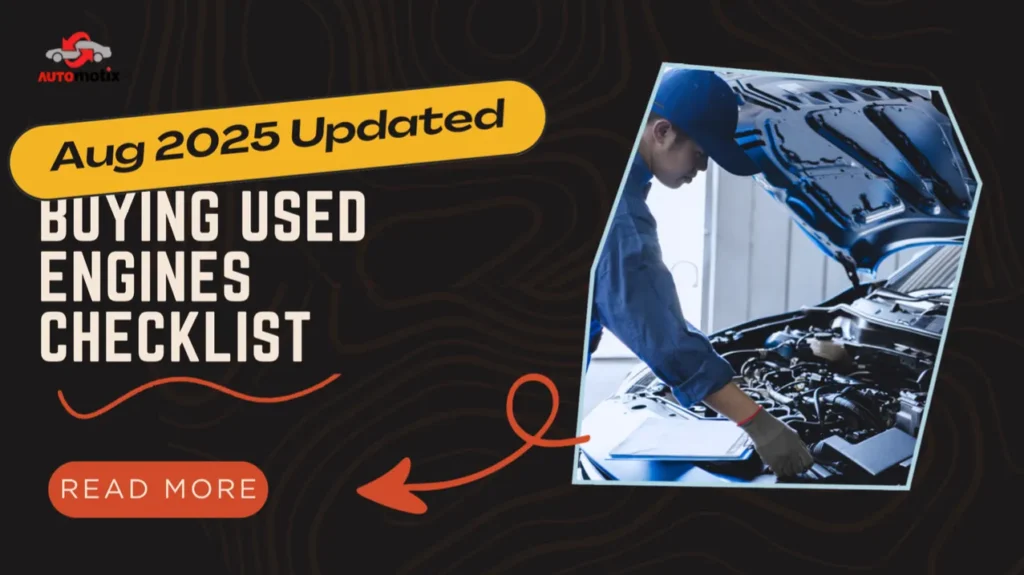
Introduction
When it comes to your vehicle, a replacement engine is a significant investment. It’s not just about getting your car running again; it’s about ensuring reliability and longevity for years to come. This checklist will help you make a smart, informed decision, helping you get your vehicle back on the road with confidence.
This comprehensive guide offers a detailed checklist for buying a used engine, meticulously covering the unique considerations for gasoline, diesel, and hybrid models. We’ll walk you through everything you need to inspect, from crucial research steps to engine-specific components, ensuring you know exactly what to look for.
At Automotix, we understand the importance of a dependable engine. We’re a trusted source for high-quality used engines across the USA, committed to providing reliable parts that meet your vehicle’s specific needs.
Summary
This comprehensive guide is your essential checklist for purchasing a used engine, covering everything from initial research to detailed inspections. You’ll learn the universal checks applicable to all engines, including verifying vehicle compatibility with engine codes, checking the donor vehicle’s VIN and mileage, and looking for a service history. We’ll then walk you through critical visual inspections for leaks, cracks, and corrosion, and simple internal health checks, such as oil and coolant condition, and the importance of a compression test. The guide also provides crucial advice on seller reputation, warranties, and paperwork. Finally, it provides engine-specific considerations for gasoline, diesel, and complex hybrid models, highlighting unique components like turbochargers, DPFs, and high-voltage battery health. By following this checklist, you’ll be well-equipped to make an informed decision and find a reliable used engine.
Table of Contents
- The Universal Checklist: What to Inspect on ANY Used Engine
- The Specialist’s Checklist: Engine-Specific Considerations
- Why Choose Automotix?
- Automotix’s Nationwide Network
- Conclusion
- Frequently Asked Questions
The Universal Checklist: What to Inspect on ANY Used
Engine
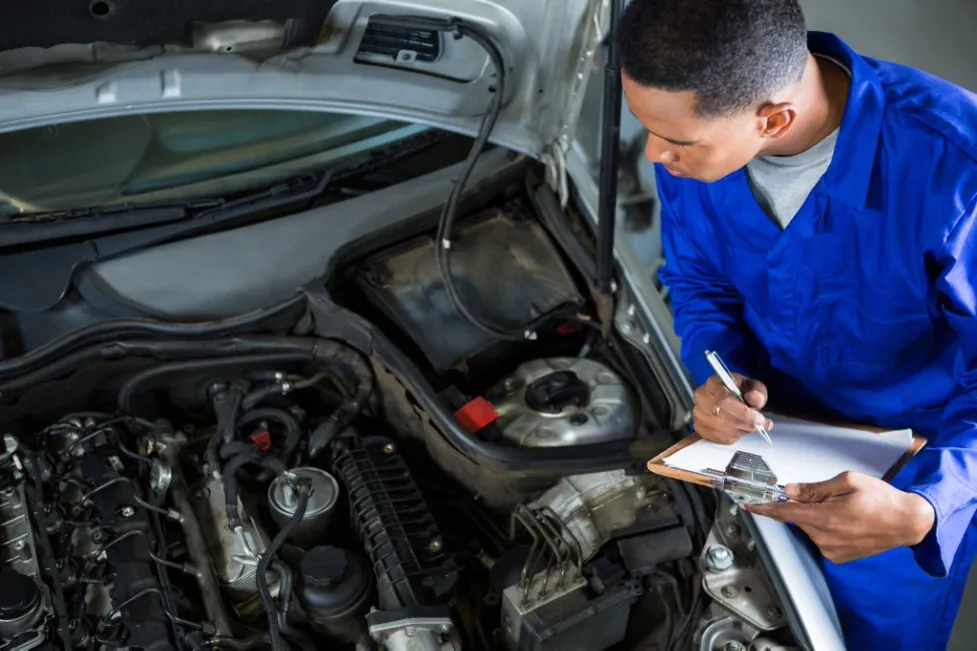
Regardless of whether you’re eyeing a gasoline, diesel, or hybrid engine, there’s a foundational checklist that applies to all. These steps ensure you’re starting with a solid, well-researched foundation before diving into engine-specific details.
Research and Verification
Before you even lay eyes on an engine, crucial research can save you a lot of headaches and money down the line.
Vehicle Compatibility
This is non-negotiable. An engine isn’t a one-size-fits-all component. You absolutely must ensure the used engine you’re considering is a perfect match for your vehicle’s exact make, model, and year. Even slight variations can lead to significant installation issues or incompatibility with your car’s existing systems.
How do you ensure this? Start with your vehicle’s engine code. This alphanumeric code is unique to your engine type and is typically found on a sticker under the hood, directly on the engine block, or in your vehicle’s owner’s manual. Cross-reference this code with the engine you’re looking to purchase. Don’t rely solely on make and model; the engine code is your definitive guide.
Vehicle Identification Number (VIN) of the Donor Vehicle
A reputable seller should be able to provide the VIN of the vehicle the engine was removed from (the “donor vehicle”). Why is this important? With this VIN, you can often obtain a vehicle history report from services like CarFax or AutoCheck. This report can reveal critical information about the donor vehicle, such as:
- Any reported accidents or major damage.
- Odometer discrepancies or rollback attempts.
- Whether the vehicle was a flood victim or salvaged. Knowing the history of the donor vehicle gives you insight into the potential life and stress the engine has endured. Learn more about Why Checking a VIN Report is Crucial.
Mileage Verification
Mileage is a significant factor in an engine’s lifespan and value. While it’s harder to verify exact
mileage on a used engine than a complete vehicle, there are ways to assess the claim:
- Donor Vehicle Records: If you have the donor vehicle’s VIN, its history report might provide odometer readings.
- Service History: Look for maintenance stickers or records that indicate mileage at specific service intervals.
- Visual Cues: While not definitive, excessively worn components (like brake pedal and interior wear) on the donor vehicle (if you can see it) might suggest higher mileage than claimed. Always be wary of claims that seem too low for the engine’s apparent condition.
Service History
An engine with a well-documented service history is always preferable. Maintenance records, such as oil change receipts, tune-up records, or major repair invoices, indicate that the engine has been properly cared for. A lack of records could suggest neglect, which can lead to premature wear and hidden problems. Ask the seller if they have any service records for the donor vehicle or the engine itself.
Visual Inspection (The “Look Fors”)
Once the research checks out, it’s time for a thorough visual inspection. This is where you become a detective, looking for tell-tale signs of wear, damage, or neglect.
Leaks
Carefully inspect the entire engine for any signs of fluid leaks. Look for:
- Oil leaks: Common areas include valve covers, oil pan gasket, front and rear main seals, and oil filter housing. Dark, greasy stains are a giveaway.
- Coolant leaks: Check hoses, radiator connections, the water pump, and around the thermostat housing. Pink, green, or orange stains (depending on coolant type) indicate a leak.
- Other fluid leaks: Depending on the engine type, also check for power steering fluid or transmission fluid leaks if those components are still attached. Fresh, wet leaks are obviously bad, but even old, dried-up stains can indicate past problems that might resurface.
Corrosion and Rust
Inspect the engine block, cylinder head, exhaust manifolds, and any exposed metal components for excessive corrosion or rust. While some surface rust on exhaust parts is normal, widespread or deep rust on the engine block itself can indicate:
- Exposure to harsh weather or road salt.
- Long-term storage in damp conditions.
- Neglect. Significant rust can compromise the integrity of components and make future repairs more difficult.
Cracks and Damage
This is critical. Look for any visible cracks on the engine block, cylinder head, intake manifold, or exhaust manifold. Cracks in these major components are often catastrophic and indicate severe issues like overheating, freezing, or impact damage. Pay close attention to areas around bolt holes and mounting points. Even hairline cracks can propagate and lead to major failures.
Condition of Belts and Hoses
Examine all visible belts (serpentine belt, timing belt if exposed) and hoses (coolant hoses, vacuum lines). Look for:
- Cracks: Especially on the ribbed side of belts and the outer surface of hoses.
- Fraying: On the edges of belts.
- Brittleness: Hoses that feel hard and inflexible.
- Bulging: Hoses that look swollen. While these are relatively inexpensive to replace, their poor condition can hint at overall neglect of the donor vehicle.
Unassembled Engines
If an engine has been taken apart and is being sold in pieces or partially assembled, be extremely cautious. Unless you are a highly experienced mechanic with the ability to meticulously inspect every single component and reassemble it correctly, it’s generally best to avoid these. There’s a higher risk of:
- Missing parts.
- Incorrect assembly.
- Hidden damage to internal components that are now exposed.
- Contamination from being open to the elements. It’s often more cost-effective and reliable to buy a complete, intact engine.
Internal Health Checks
While you can’t fully disassemble an engine for inspection, a few simple checks can reveal a lot about its internal health.
Oil Condition
Color and Consistency: Ideally, the oil should be amber or light brown. Dark, thick, or sludgy oil indicates a lack of regular oil changes and poor maintenance.
Metal Shavings: Look closely for any metallic flakes or glitter in the oil. This is a major red flag, indicating severe internal wear or damage to bearings, camshafts, or other critical components.
Milky or Frothy Oil: This is the most serious sign. Milky or frothy oil, often resembling chocolate milk, indicates that coolant has mixed with the oil. This is a strong indicator of a blown head gasket, cracked cylinder head, or a cracked engine block, all of which require extensive and costly repairs.
Coolant Condition
If accessible, remove the radiator cap (only when the engine is cold!) or check the overflow reservoir. The coolant should be clean and clear, matching its original color (e.g., green, orange, pink).
Rust or Debris: Brownish, rusty coolant suggests a neglected cooling system, which can lead to corrosion and blockages.
Oil Slicks: Any oily residue or film on the surface of the coolant indicates a breach between the oil and cooling systems, again pointing towards a blown head gasket or internal crack.
Compression Test
A compression test is one of the most reliable ways to assess the internal health of an engine’s cylinders. It measures the pressure inside each cylinder when the piston is at its highest point. A good seller might have already performed this and can provide the results; if not, it’s worth asking if they can do one or if you can arrange for it.
- Why it’s crucial: It helps diagnose issues with piston rings, valves, and head gaskets. Low compression in one or more cylinders means the engine isn’t sealing properly, leading to power loss, misfires, and excessive oil consumption.
- Ideal Readings: You want consistent compression readings across all cylinders, ideally within the manufacturer’s specified range. A variation of more than 10-15% between the highest and lowest cylinder readings is a cause for concern.
- Problematic Readings: A very low or zero reading in a cylinder indicates a significant problem, such as a burnt valve, holed piston, or severely damaged head gasket. Understanding The Importance of a Compression Test can help you interpret results.
Seller and Purchase Logistics
Beyond the engine itself, the terms of sale and reputation of the seller are equally important for a smooth and secure purchase.
Reputable Seller
Buying a used engine is not like buying a small accessory. It’s a significant investment, and the seller’s reputation matters immensely. Look for:
- Established Businesses: Companies with a physical location and a history of selling used auto parts.
- Positive Reviews: Check online reviews (Google, Yelp, BBB) for feedback on their product quality, customer service, and warranty claims.
- Transparency: A good seller will be upfront about the engine’s history, condition, and any known issues. They won’t pressure you into a quick sale.
Warranty
A warranty is your protection against unforeseen issues. Do not purchase a used engine without one. A good warranty should:
- Cover Key Components: Specify what parts of the engine are covered (e.g., block, cylinder head, crankshaft, pistons, rods).
- Include Labor (Ideally): Some warranties cover not just the part but also the labor cost for removal and installation if the engine fails. This is a huge plus.
- Specify Duration: Common warranty periods range from 30 days to 6 months, or even a year for higher-quality engines. Longer is always better.
- Outline Conditions: Understand what voids the warranty (e.g., improper installation, overheating, lack of maintenance).
Return Policy
Even with a warranty, a clear return policy is essential. Understand:
- Return Window: How long do you have to return the engine if it’s incorrect or defective?
- Conditions: Does it need to be in its original packaging? Are there any specific conditions for return (e.g., not installed, not damaged)?
- Restocking Fees: Some sellers charge a restocking fee for returns that aren’t due to a defect. Be aware of this.
Price Comparison
Research is key here. Get quotes from several different sellers for comparable engines (same make, model, year, mileage range, and warranty). Be wary of prices that seem “too good to be true” – they often are. A significantly lower price might indicate hidden problems, a lack of warranty, or a less reputable seller. Balance price with the seller’s reputation and warranty offerings.
Paperwork
Always insist on proper documentation for your purchase. This should include:
- A detailed Bill of Sale: This should clearly state the engine’s year, make, model, VIN (if applicable), mileage (if known), and the purchase price.
- Warranty Documentation: A separate document outlining the terms and conditions of the warranty.
- Any other relevant documentation: Such as the donor vehicle’s VIN or any service records provided. This paperwork is vital for any future claims, to prove ownership, and for your own records.
The Specialist’s Checklist: Engine-Specific Considerations
When purchasing a used engine, whether gasoline, diesel, or hybrid, knowing what to inspect even from afar via detailed photos and provided information can make all the difference. This checklist highlights critical components unique to each engine type, giving you an insider’s perspective on what truly indicates quality and reliability.
Buying a Used Gasoline Engine
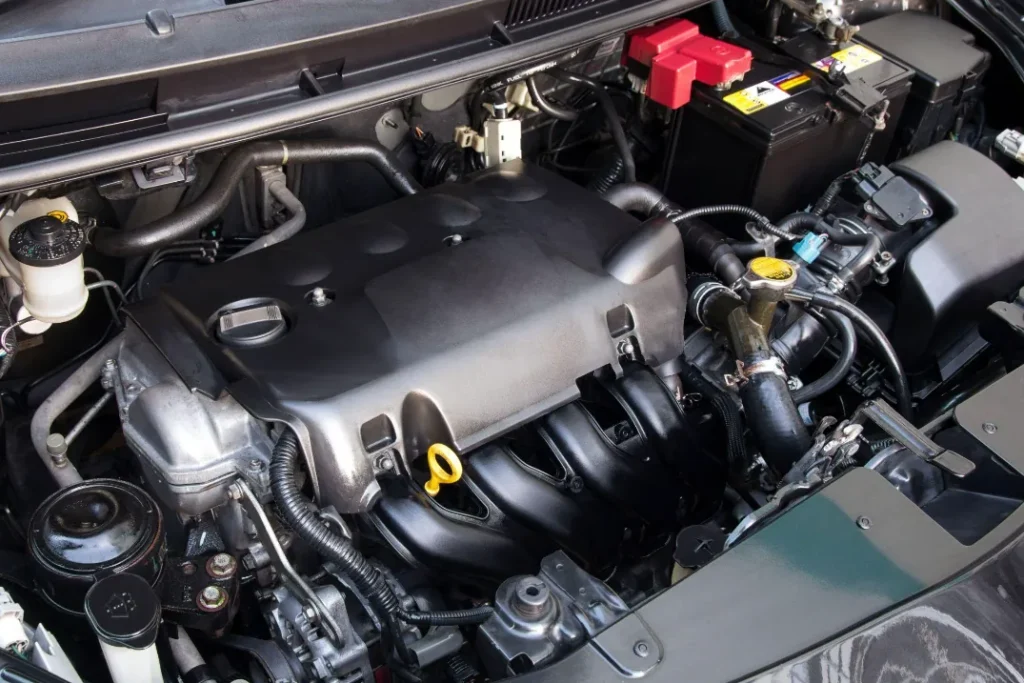
While our focus here is on hybrids, it’s useful to understand the benchmarks for all engine types. For a used gasoline engine, pay attention to:
Spark Plugs: If visible in product photos, look for signs of extreme wear, excessive carbon buildup, or oil fouling (which can indicate internal engine issues like worn valve seals or piston rings). Clean, light brown electrodes are a good sign.
Timing Belt/Chain: Inquire about the maintenance history of this critical component. If the engine uses a timing belt, ask about its last replacement. If no record is available and the mileage is high (typically 60,000-100,000 miles), budget for its immediate replacement. Timing chains are designed to last longer, but should still be free of excessive slack or unusual noises.
Fuel System: Inspect the fuel rails, injectors, and lines for any visible signs of leaks, corrosion, or damage. While injectors aren’t always easily visible, clean fuel lines and rails indicate better care.
Turbocharger (if applicable): Many modern gasoline engines are turbocharged. If present, inquire about its condition. A healthy turbocharger should not have excessive shaft play (wiggle in the turbine shaft) or visibly damaged fins. Ask about any signs of blue smoke from the exhaust of the donor vehicle, which could indicate a failing turbo seal.
Buying a Used Diesel Engine
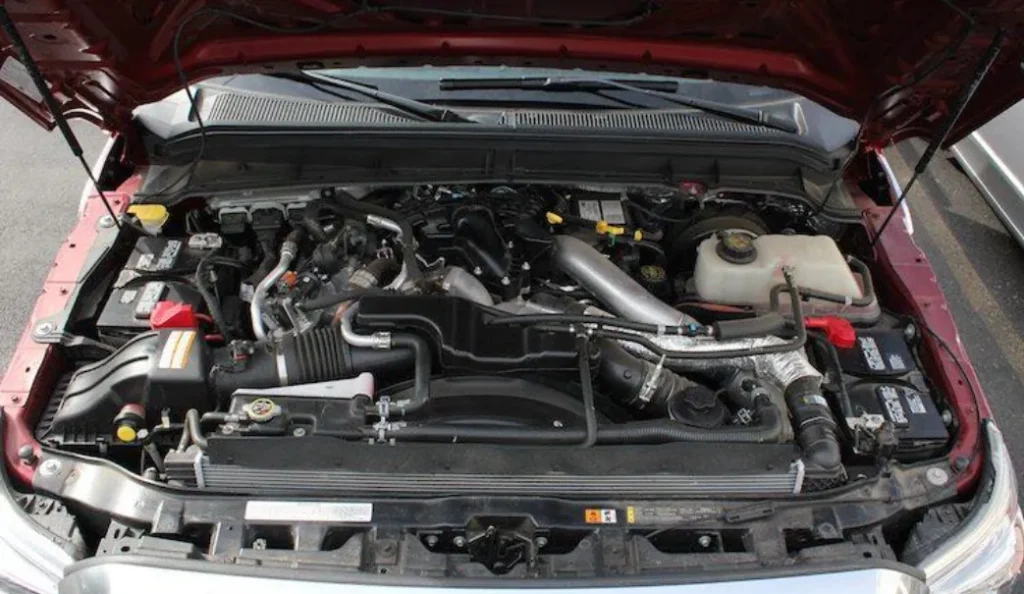
The open hood of a red truck reveals a powerful and complex diesel engine.
Diesel engines are built for durability, but have their own unique inspection points:
- Glow Plugs: Crucial for cold starts, especially in colder climates. While not something you can visually inspect easily on a disassembled engine, their proper function in the donor vehicle’s history is important. Malfunctioning glow plugs lead to hard starting and rough idling when cold.
- Turbocharger: Diesels are almost universally turbocharged, making this a critical component to check. Look for any signs of oil leaks around the turbo housing or intercooler pipes. Inquire if there were any reports of unusual whistling or grinding noises from the donor vehicle.
- Fuel Injectors: Signs of problematic diesel injectors include excessive black or white smoke from the exhaust, rough idle, poor fuel economy, or a strong diesel smell. While direct inspection is difficult, questions about the donor vehicle’s running condition are key.
- Exhaust Gas Recirculation (EGR) System: EGR valves can become clogged with carbon in diesel engines, leading to rough idling, reduced power, and increased emissions. Ask about any diagnostic trouble codes related to the EGR from the donor vehicle.
- Diesel Particulate Filter (DPF): This exhaust component traps soot. Check for any signs of physical damage, or, more importantly, a history of frequent regeneration issues or, illegally, DPF removal (which would make the engine non-compliant for road use). A clogged DPF can significantly impact engine performance.
- “Blow-by”: This refers to combustion gases escaping past the piston rings into the crankcase. Excessive blow-by can indicate worn piston rings or cylinder walls, leading to power loss and oil consumption. While harder to check on a standalone engine, in a running donor vehicle, it’s often indicated by excessive pressure when removing the oil filler cap or dipstick.
Buying a Used Hybrid Engine/Drivetrain
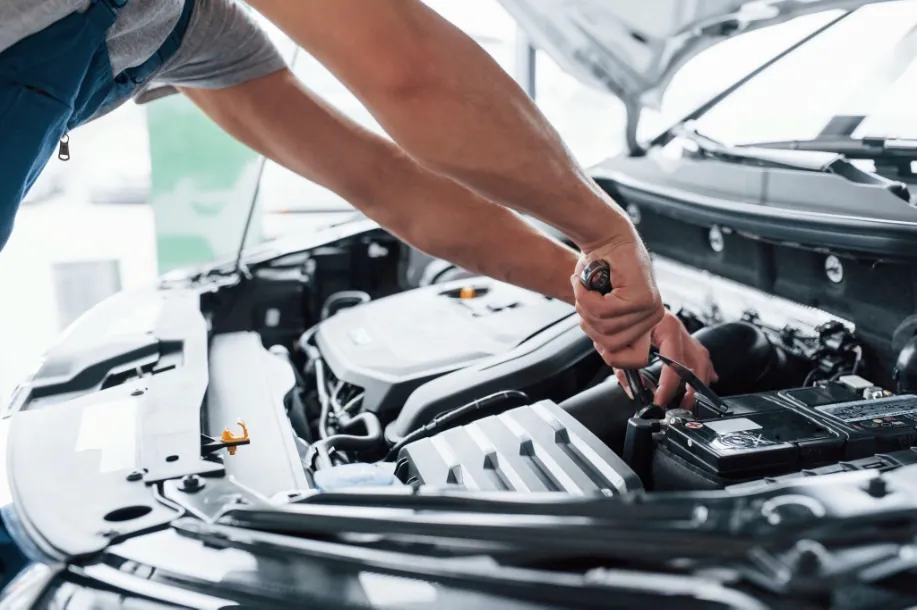
Hybrid systems introduce a layer of electrical complexity to the traditional engine. When sourcing a used hybrid engine, your checklist needs to go deeper:
High-Voltage Battery Health
This is arguably the most critical and potentially most expensive component of the entire hybrid system. While often sold separately from the engine itself, if the engine is part of a “drivetrain” assembly or you’re buying a complete vehicle, this is paramount.
- Ask for a battery health report or diagnostic check: Reputable dismantlers or sellers might be able to provide data from specialized diagnostic tools (like a “Dr. Prius” or similar scanner output) showing the State of Health (SOH) of the battery pack, often presented as a percentage. This indicates its remaining capacity relative to the new.
- Check the battery’s age and replacement history: Batteries degrade over time and cycles. Even a low-mileage car might have an older battery. Inquire if the hybrid battery has ever been replaced, and if so, when.
Inverter and Converter
These crucial power electronics manage the flow of high-voltage electricity between the battery, electric motor(s), and other vehicle systems. Their replacement is costly.
- Look for signs of overheating (discoloration, burnt smells) on the unit’s casing in photos.
- Inquire if the donor vehicle experienced any sudden power loss, warning lights (like “Check Hybrid System”), or a “red triangle of death” (common in some Toyota/Lexus models), which can often indicate inverter issues.
Regenerative Braking System
While this system primarily involves the electric motor and power electronics, issues can still manifest.
- If possible, inquire about the donor vehicle’s braking feel. Unusual noises (whining or grinding) or a pulsing sensation during braking could suggest issue with the electric motor’s regenerative function or its seamless transition with the friction brakes.
- This is typically checked through professional diagnostic tools that monitor the system’s energy recovery efficiency.
Cooling System for Hybrid Components
Hybrid systems often have multiple, distinct cooling circuits for the gasoline engine, the inverter, and the high-voltage battery.
- Verify the condition of visible coolant reservoirs and hoses for the hybrid-specific cooling loops.
- Ask if there were any overheating issues reported for the hybrid system (distinct from engine overheating). Overheating of the inverter or battery can cause significant damage.
- Ensure there are no signs of leaks around these dedicated hybrid cooling lines.
Service History from a Qualified Hybrid Technician
This is vital for any used hybrid component. A comprehensive service history from a dealership or a specialist hybrid repair shop can provide invaluable insights into the overall health and previous care of the hybrid system. It indicates that the vehicle received the specific attention required for its complex technology, which often includes diagnostic checks of the battery and electrical systems, not just routine oil changes.
By focusing on these specific points, you empower yourself to make a more informed decision when investing in a used hybrid engine, ensuring you choose a reliable and long-lasting replacement.
Why Choose Automotix?
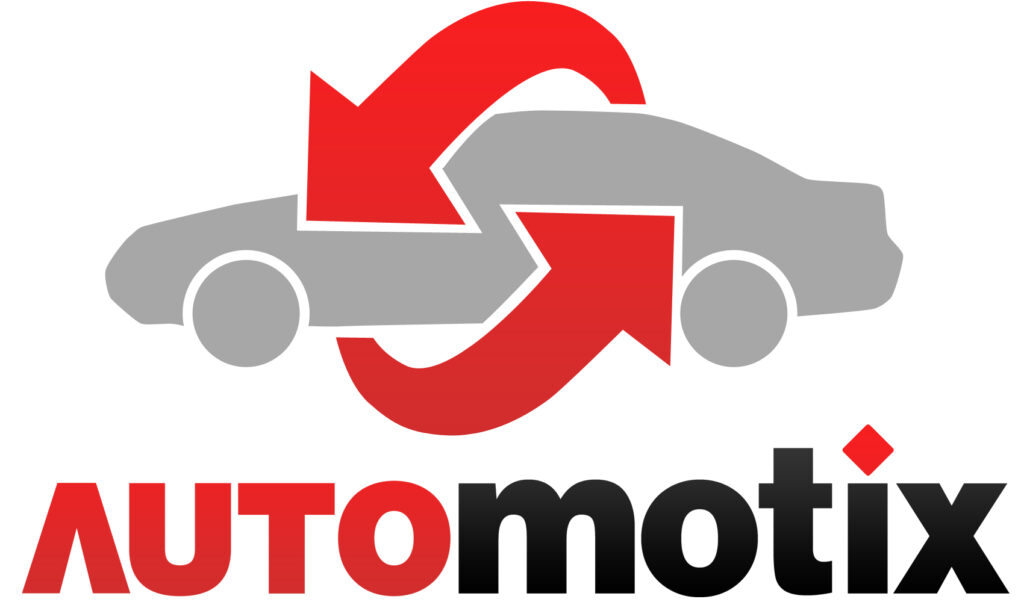
When you’re dealing with something as vital as an engine, you need more than just a part; you need a partner you can trust. At Automotix.net, our entire operation is built around providing that confidence. We understand the unique complexities of engines and have tailored our services to ensure your peace of mind.
Our Meticulous Sourcing and Inspection Process
Quality isn’t just a promise at Automotix; it’s the bedrock of our business. We know that the reliability of a used engine begins long before it arrives at your door.
We partner exclusively with a nationwide network of highly reputable salvage yards and automotive recyclers. Our acquisition specialists employ a meticulous selection process for donor vehicles, prioritizing those with verifiable low mileage, documented maintenance histories, and minimal or no impact to the engine or components in the event of an accident.
Once a potential engine is identified, it undergoes a rigorous multi-point inspection and testing process:
- Comprehensive Visual Inspection: Our technicians meticulously examine the engine for any visible signs of external damage, fluid leaks, excessive corrosion, or missing components. For hybrid engines, this includes a careful check of the electric motor housing, inverter unit (if integrated), and all associated high-voltage cabling and cooling lines for integrity.
- Performance Verification: Where possible, we verify the operational integrity of the engine. This can include running a compression test to assess cylinder health and, for components still within the donor vehicle, observing its starting and running condition.
- System Integrity Checks: For hybrid engines, we prioritize units where the hybrid system was fully functional before dismantling. We look for any diagnostic trouble codes (DTCs) that would indicate issues with the engine, electric motor, or power control unit.
- Detailed Documentation: Every engine is cataloged with precise details, including the donor vehicle’s VIN, mileage, and any relevant historical notes, ensuring complete transparency.
Comprehensive Warranty and Unwavering Customer Support
We stand firmly behind the quality of every used hybrid engine we sell. Unlike some suppliers, Automotix.net offers comprehensive warranties on our used engines. This warranty is a direct reflection of our confidence in our stringent sourcing and testing processes, providing you with crucial protection for your significant investment. We believe that a reliable used part, especially one as complex as an engine, should come with reliable backing.
Our warranty and return policies are straightforward and transparent, ensuring you fully understand your coverage and options. Should a rare issue arise, our dedicated customer support team is ready to assist you every step of the way, guiding you through the resolution process with efficiency and care.
Decades of Expertise, Across All Engine Types
With over two decades of experience in the auto parts industry, the Automotix team possesses unparalleled expertise across all types of engines – gasoline, diesel, and increasingly, complex hybrid drivetrains. Our customer service representatives aren’t just order-takers; they are highly knowledgeable specialists who understand the nuances of engine compatibility and hybrid system integration.
We are equipped to help you verify compatibility using your VIN and engine codes, answer technical questions specific to hybrid components, and guide you through the selection process, ensuring you find the precise engine for your vehicle’s unique specifications.
Fast, Reliable, Nationwide Delivery
Getting your vehicle back on the road quickly is paramount. Automotix utilizes a network of trusted freight carriers to ensure your used hybrid engine reaches you swiftly and safely, no matter where you are in the contiguous USA. Every engine is professionally crated and secured to prevent damage during transit, ensuring it arrives at your mechanic’s shop or your doorstep in the same, inspected condition it left our facility. We provide tracking information so you can monitor your shipment’s progress, keeping you informed until your hybrid engine is ready for installation.
Choose Automotix for your used hybrid engine, and choose the peace of mind that comes with industry-leading quality, expert support, and a commitment to your satisfaction.
Automotix’s Nationwide Network
While guaranteed compatibility is crucial, Automotix goes a step further. Our nationwide network of professional auto recyclers and suppliers means we don’t just find an engine that fits your application; we often provide multiple options for the same vehicle. This allows you to choose an engine based on various factors beyond just fit, such as mileage, specific quality assurances, and even price points, ensuring you get the best possible value that aligns with your needs and budget. We empower you with choices, so you’re not just getting a replacement part, but the right replacement part for you.
Conclusion
Buying a used engine is a significant decision, but with the right knowledge and a thorough approach, you can make a choice that ensures your vehicle’s reliable performance for years to come. This checklist has armed you with the essential steps, from critical research and verification of the donor vehicle’s history to meticulous visual inspections and crucial internal health checks. We’ve also highlighted the specific considerations for gasoline, diesel, and complex hybrid engines, empowering you to identify a quality replacement regardless of your vehicle type.
Remember, a dependable used engine isn’t just about the component itself; it’s about the confidence that comes from knowing its history, its condition, and the trustworthiness of your supplier. At Automotix, we are committed to providing that assurance through our meticulous sourcing, rigorous inspection processes, comprehensive warranties, and unparalleled expertise across all engine types.
Ready to get your vehicle back on the road with a high-quality, reliable used engine? Browse our extensive inventory of used engines today or connect with our experts who are standing by to help you find the perfect match for your vehicle’s needs. Choose Automotix for peace of mind and lasting performance.
Frequently Asked Questions
Q: Is it really safe to buy a used engine?
A: Yes, absolutely! When purchased from a reputable seller who provides a detailed history, performs thorough inspections, and offers a comprehensive warranty, a used engine can be a highly reliable and cost-effective solution. The key is to follow a detailed checklist and choose a trusted supplier like Automotix.
Q: How can I be sure the used engine is compatible with my vehicle?
A: Vehicle compatibility is non-negotiable. The most accurate way to ensure a perfect match is by using your vehicle’s engine code and cross-referencing it with the used engine you’re considering. This code is typically found on a sticker under your hood, on the engine block, or in your owner’s manual. Providing your Vehicle Identification Number (VIN) to a knowledgeable seller, like those at Automotix, can also help verify compatibility.
Q: What’s the most important thing to check during a visual inspection?
A: While all visual checks are important, closely inspecting for cracks on major components (like the engine block or cylinder head) and signs of fluid leaks (especially milky oil or oil in the coolant) are critical. These can indicate severe, often catastrophic, internal damage.
Q: Why is a compression test so important?
A: A compression test is like a vital signs check for an engine. It measures the pressure in each cylinder and helps reveal problems with piston rings, valves, or head gaskets. Consistent, healthy compression across all cylinders indicates good internal engine health, while low or inconsistent readings are major red flags.
Q: What kind of warranty should I look for when buying a used engine?
A: Always insist on a warranty. A good warranty should clearly state what components are covered, the duration of coverage (typically 30 days to a year), and ideally, include labor costs if the engine fails due to a covered defect. Be sure to understand any conditions that could void the warranty. Automotix offers comprehensive warranties for your peace of mind.
Q: How does buying a used hybrid engine differ from buying a gasoline or diesel engine?
A: Hybrid engines have additional electrical components. Beyond the universal checks, you must inquire about the High-Voltage Battery Health (often via a diagnostic report) and inspect the Inverter and Converter for signs of overheating or damage. Checking the dedicated cooling systems for hybrid components is also crucial, as is getting service history from a qualified hybrid technician.
About the Author / Automotix Team:
This guide was crafted by the seasoned experts at Automotix, a leading name in the used auto parts industry since 2000. With over two decades of dedicated experience, our team has been at the forefront of connecting buyers with high-quality, certified used OEM auto parts across the USA. We pride ourselves on leveraging cutting-edge technology to streamline the auto parts buying experience, offering an unparalleled inventory and a commitment to customer satisfaction that has established us as a trusted authority. Our mission is to empower car owners, DIY mechanics, and repair shops with the knowledge and the right parts to keep vehicles running efficiently and affordably, contributing to both individual savings and a more sustainable automotive future.


